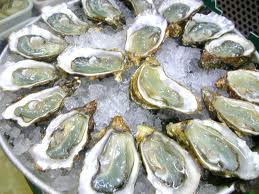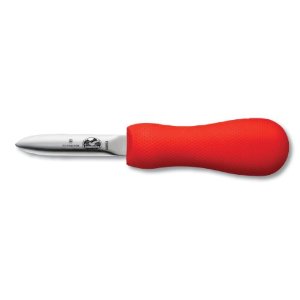To shuck an oyster.
It occurs to the Editor, belatedly she would admit, that after rattling on about oysters for an entire Number she has written not a word about how to go about rendering them useful.
Shucking creates fear in the heart of the veteran as well as neophyte; even the uninhibited Hugh Fearnley-Whittingstall admits in The River Cottage Fish Book that he is ‘not so keen.’ At britishfoodinamerica, we admit that we shared his reluctance until recently. Then, courtesy of Rowan Jacobsen, we toughened up and took to shucking. It is neither easy nor hard, but rather manageable fun once you find the right technique.

Different shuckers swear by different approaches, it is true. In The Geography of Oysters, Jacobsen offers the best instruction we have found for shucking the oyster. It is particularly welcome when attempting to shuck the delicious northeastern American oysters with their delicate cultivated shells. Most of these oysters are cosseted during their entire lives so need not, and do not, develop sturdy shells. That does not affect their flavor but does make it harder to shuck them because the shells want to shatter.
The fourfold key is no secret. Get the right knife, set the oyster on a dishtowel (in Britain, more elegantly, a tea towel), attack the narrow hinge of the oyster and handle that right knife in the right way on the attack.
Most imposters sold as oyster knives are worthless. They have shields to obscure your view of the shell and use crappy steel that will bend. You would fare better with a screwdriver, if not too well. You need a short, sharp stabbing knife made especially for opening oysters.
The characteristics of the blade will vary, if only a little. The length changes with the size of the oysters you will shuck; Gulf giants want a longer blade, tiny Olympias something small and sizes between them get their own dimensions. The width of the blade also may vary.
Each blade, or pattern, gets its name from a city near the beds where oysters of a particular size grow. The Galveston pattern (wider, four inch long blade) therefore is longer than the Providence pattern (narrow; two and three quarter inches) and so on.
Some blades--the New Haven pattern--have a bent tip designed to reduce the risk of mangling the meat as you slip the knife across the shell. Jacobsen, who lives in Vermont but buys oysters from all over the United States, likes the Connecticut variant best but appears unaware of the others. The Editor likes the flat bladed Providence pattern for the obvious reason that our oysters come mostly from southern New England waters.
The shape of the handle matters too. It should bulge at the base to support and protect your thumb, then narrow to give your fingers good purchase and then bulge bigger than the front to hold your thumb for pushing hard into the hinge.
Good knives cost from ten to fifteen bucks. Manufacturers include Dexter-Russell, Oxo, Sani-Safe and Victorinox but beware; some of them also sell the wrong kind of oyster knife, whether shielded, elliptical or otherwise inadequate. Yours should look something like this:

Providence style oyster knife
It is surprising how hard it is to find these knives on the brick and mortar, even in eastern oyster country, but infinite variations do appear online at Amazon.com, Acme Kitchen and Beyond, Cutlery Mania, the WEBstaurant Store and others.
Always set the oyster in a towel on a counter with its deep shell down and shallow one up. Loop the towel around the oyster so that the narrow, pointy end of its shell protrudes.
Take the proper blade and ram it, hard, into the narrow end of the shell, to the left or right of the tip; take the approach that makes you comfortable. Do not twist the knife; that will only crumble the shell, making it harder to pry the oyster open and also adding unwelcome shards to what you want to eat. A good shove is your best move here, but if you must, then pry the knife up and down with vigor. No half measures will help you prepare an oyster on the half shell.
The shells will pop, almost audibly, and once the initial breach gets broken, you can run your blade--carefully, do not cut the meat--along the underside of the top shell before prying it back and off. You now need only slice away the adductor muscle that attaches the oyster to its deeper shell. Be careful not to spill the precious liquor, then bombs away: The oyster is yours.

